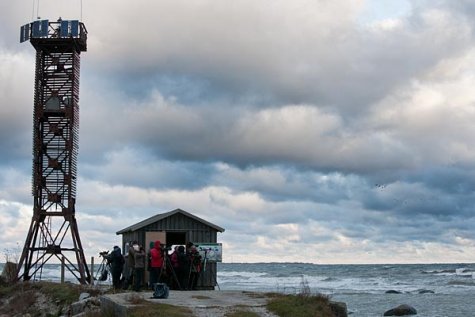New bird observations database
Photo: Arne Ader
Translation: Liis
Birdwatching at Põõsaspea
Hello, all bird friends!
Birdwatchers have felt the lack of a proper database for observations for several years. Data have been entered in various databases and on home pages, making integrated searches difficult. Last year the Estonian Ornithological Society and Estbirding decided that the eElurikkus resources developed at the University of Tartu (UT) Natural History Museum could be used.
What is eElurikkus?
eElurikkus is a web-based interface that displays information on biodiversity in Estonia. It includes databases in taxonomy, ecology, phylogenetics, conservation and other areas owned by individuals, workgroups or institutions and built on a common database platform, PlutoF
More detailed information is on the eElurikkus web page
The observations module already existed in the eElurikkus, for bird observations only certain developments were needed. Today the work is so far advanced that we can open the bird observations database to all who would like to enter data. In fact birdwatchers have been using the database already for more than six months; as “guinea pigs“ all who were interested could join in. Many thanks to all testers, and special thanks to Kessy Abarenkovile for the technical development of the database, and to Uku Paal and Hannes Pehlak for development of the contents.
Some of our readers have certainly made acquaintance with the observations part of the eElurikkus. The database is at the same address as earlier:
The “Observations“ link leads directly to bird observations and as default observations from the last week are displayed. To enter data, users must log in with their user identification. New users please send your registration application to:
Observations from experienced watchers become available immediately on entering the data. Observations from novices must first be approved by the administrators. At present administrators of the contents of the observations are three members of the Bird Rarities Committee (Margus Ots, Uku Paal, Hannes Pehlak), but the group will be extended as needed.
Who owns the data in eElurikkus?
The owners of data are the observers or the workgroups that enter the data.
The UT Natural History Museum offers only the opportunity to use the database. All data entered in the public database are freely available to everyone who wishes to use them; anyone may download the entire database and use it for analyses. An exception is protected species for which all data will not be publicly displayed. For some species all observations are classified, for others the precise data on nesting locations in connection with observations on breeding. These data will be available only to staff of the Environmental Board or the Estonian Ornithological Society or species experts who need data for their work on protected species.
Anyone can also create a wholly closed database at the eElurikkus in which the entered data are only available to the person entering them or members of a workgroup. As an example the data from a monitoring project may first be open only to the workgroup but after publication of the results the base data can later be made available to all.
What will happen to other data bases?
All existing data bases may of course remain as they are.
Whether this is rational is a different question. It is however of greater importance that the existing databases co-operate and that searching in one it should also be easy to retrieve data from the other databases.
In further development work this will be one of the main activities.
An agreement has been made regarding the Kabli Bird Station database that it will be closed for random observations from the whole of Estonia. In practice already now a great part of the Kabli bird station database has been transferred to the eElurikkus.
Several web sites (including bird clubs) plan to add a link to a corresponding search result in the eElurikkus instead of as now setting up the data as a text file on their pager, as for instance observations from one county. Using the eElurikkus data base has been discussed in the Bird Rarities Committee.
The Estonian Ornithological Society, Estbirding and the UT Natural History Museum invite all to make acquaintance with the eElurikkus bird observations database and to use it. As of now the database already contains 55 000 observations!
Sincerely,
Margus Ots
Estonian Ornithological Society, Vice Chairman of the Council; Estbirding, Chairman; UT Natural History Museum, Deputy Director









